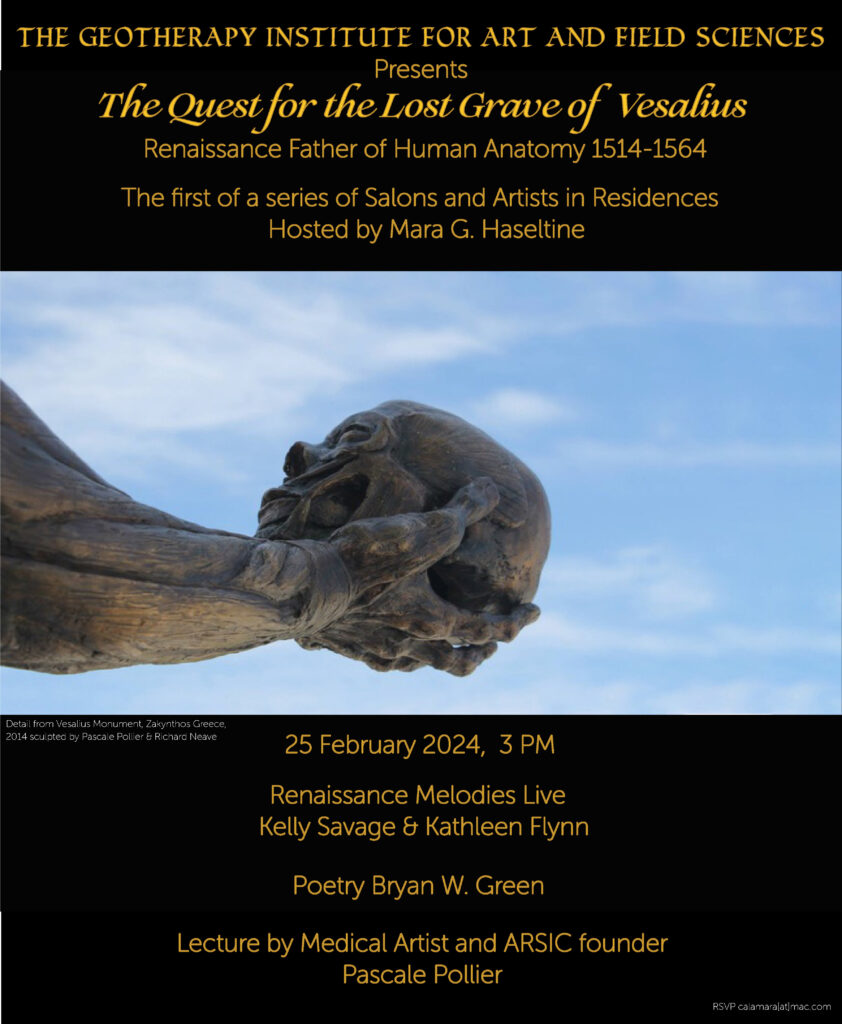
I am delighted to be hosting a series of Salons dedicated to infusing the field sciences with art and poetry with my newly formed NGO, The Geotherapy Insititute for Art and Field Sciences. Our first salon will focus on the life and work of Andreas Vesalius, a Flemish Rennisance physician who is considered The Father of modern anatomy whose work marks the first true collaboration between scientists and artists in Europe.
RSVP required to attend live please email: calamara@mac.com
The Quest for the Lost Grave of Vesalius
Program
25 February 2024, 3 PM
Words of Welcome by Director of the Geotherapy Institute for Art and Field Sciences: Mara G.Haseltine
Hosting The first of a series of Salons and Artists in Residences
Rennisance Melodies Live!

Kelly Savage, Harpsichord

Kathleen Flynn, mezzo-soprano & writer
Music:
CLAUDIA SESSA (circa 1570 – circa 1617/19)
Occhi io vissi di voi
Vattene pur lasciva orrechia umana
ALBA TRISSINA (circa 1590 – after 1638)
Vulnerasti cor meum
Quaemadmodum
ROBERT PARSONS (ca. 1535 –1571)
Pandolpho
MARIN MARAIS (1656- 1728)
Tableau de l’Opération de la Taille (the Stone Surgery, 1725), arranged for solo harpsichord and narrator.
Poetry program

Forasmuch as Bryan W. Green, a sculptor seduced by the word poet and a poet fascinated by the outstanding figure of man,
bold against a backdrop of time and space, claims that Vesalius was thrust upon him in a monumental manner,
he had to carve these words out of the mental block of history and the lost marbled wane-wax thoughts of the future.
Bryan will be reciting and performing 3 Poems,
Vesalius,
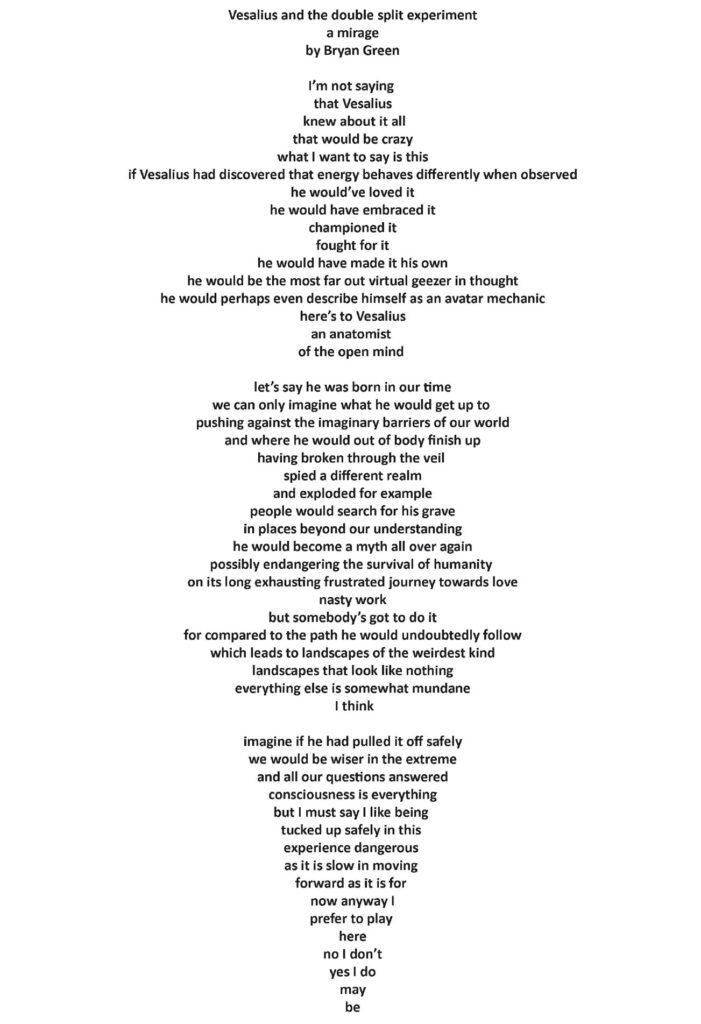
“The Quest for the Lost Grave of Andreas Vesalius, The Father of Human Anatomy”
Lecture: “The quest for the lost grave of Andreas Vesalius, The Father of Human Anatomy”
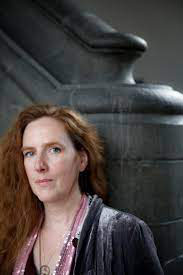
By Pascale Pollier : Medical Artist Founder of ARSIC & The Vesalius Continuum
The quest for the lost grave of Andreas Vesalius is a Scientific-Artistic project in collaboration with prominent researchers, Theo Dirix and artist Pascale Pollier-Green
The Renaissance anatomist Andreas Vesalius revolutionized medical knowledge by creating and publishing the intricately illustrated “De humani corporis fabrica.” This ground-breaking anatomy book, mapping the human body in unprecedented detail, has endured as the most renowned work of its kind in history. Despite our extensive understanding of Vesalius and the production of the Fabrica, the identities of the artist behind its illustrations, such as Jan Stephan von Calcar, a student of Titian, remain enigmatic. Nevertheless, this artist, collaborating with Vesalius, played a pivotal role in shaping medical illustration for centuries.
In 2009, Pascale, inspired by her completion of a facial reconstruction course in Maastricht, conceived the idea of reconstructing the face of the eminent anatomist Andreas Vesalius. Despite uncertainties surrounding Vesalius’s burial, believed to be in Brussels, Pascale and her colleague Ann van de Velde embarked on a quest for the truth. Their journey led them to the Ionian Island of Zakynthos in Greece, where Vesalius’s death had remained a mystery for over four centuries. Intriguingly, various theories surrounding the cause of his death and the exact burial site, ranging from shipwreck to disease, prompted their determination to uncover the truth. Sailing to Zakynthos, they explored potential sites, including the lost Franciscan monastery in Pantokratoras and the church of Santa Maria delle Grazie. During their quest, letters discovered by esteemed Belgian researchers Omer Steeno, Maurits Biesbrouck, and Theo Godeeris revealed an alternative theory associated with the Franciscan monastery ‘Annunciata’ at Santa Maria delle Grazie, as mentioned by Flemish author Giovanni Zuallardo in 1586. Unfortunately, the epitaph was lost in 1571, deepening the layers of intrigue surrounding their investigation.
In the words of Pascale Pollier herself,
“A decade later, we are delighted to unveil our comprehensive findings derived from the application of advanced technologies at the archaeological site of Santa Maria Della Grazia in Zakynthos. Our primary objective was to ascertain the burial place of Vesalius, and these cutting-edge methods have provided invaluable insights and results.
Our quest is ongoing the next step will hopefully be locating the exact spot of the burial site! If we do find the exact location, our intention is to conduct an excavation and perform a facial reconstruction on the skull of Andreas Vesalius. Additionally, I envision creating a digital facial reconstruction and animating the reconstruction of the face to develop an interactive avatar of Vesalius. The ultimate goal is to transform this avatar into an educational app, allowing the pioneering anatomist to come back to life digitally. Through this innovative approach, Vesalius could become a virtual teacher, a blast from the past, imparting anatomical knowledge to modern medical students. I believe such a technological homage aligns with Vesalius’s spirit of exploration and education, making it a fitting tribute to his legacy.”
http://www.artem-medicalis.com/
The standout images in Book II of Vesalius’s work are the Muscle Men. These illustrations showcase men in various stages of dissection against the backdrop of the Euganean hills near Venice and Padua, Italy. When assembled, these images create a continuous panorama, blending the scientific study of the human body with the natural world.
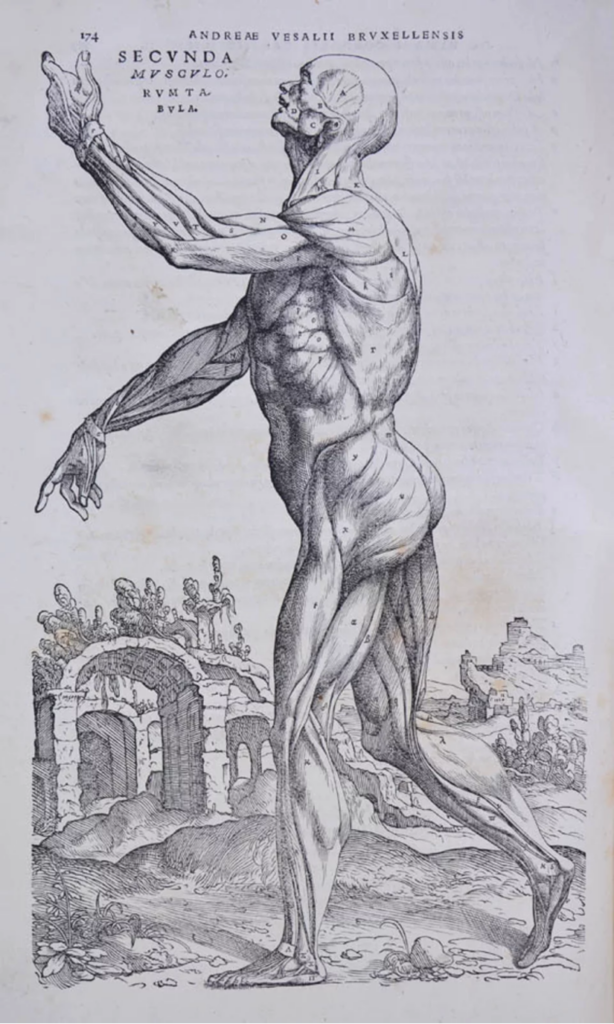
In collaboration with forensic medical artist Richard Neave, Pascale sculpted a commemorative monument for the 500th anniversary of Vesalius’s birth. The monument features an ecorche holding a skull, symbolizing the ongoing quest for Vesalius’s grave. The ecorche is inspired by two illustrations from Vesalius’s masterpiece anatomy book; “The Fabrica”. One illustration depicts a contemplative skeleton with a bowed posture, accompanied by the inscription on the plinth: “vivitur ingenio, caetera mortis erunt” (“genius lives on, all else is mortal”). The second ecorche points skyward, symbolizing a philosophical perspective that transcends the limitations of the physical body, suggesting there is more to life beyond our corporeal existence.
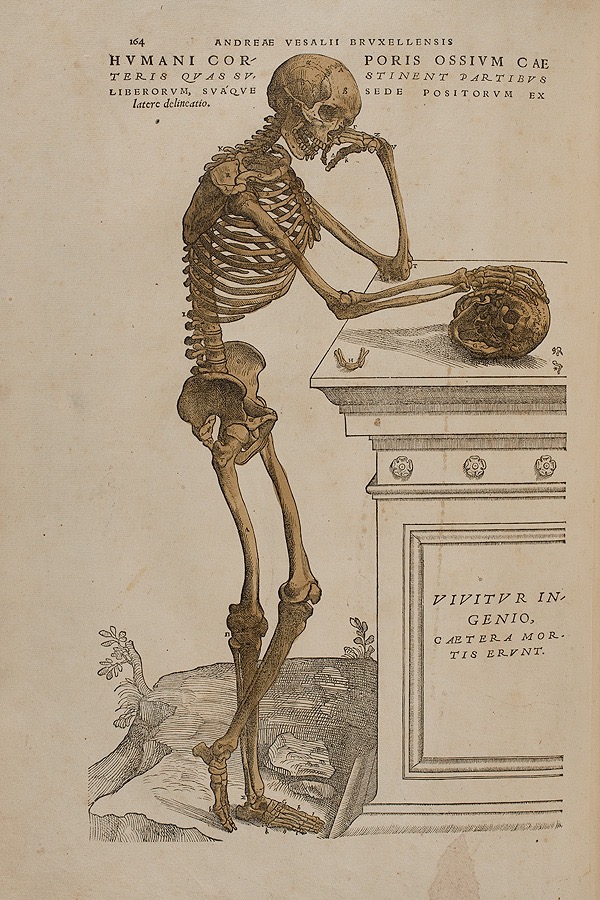
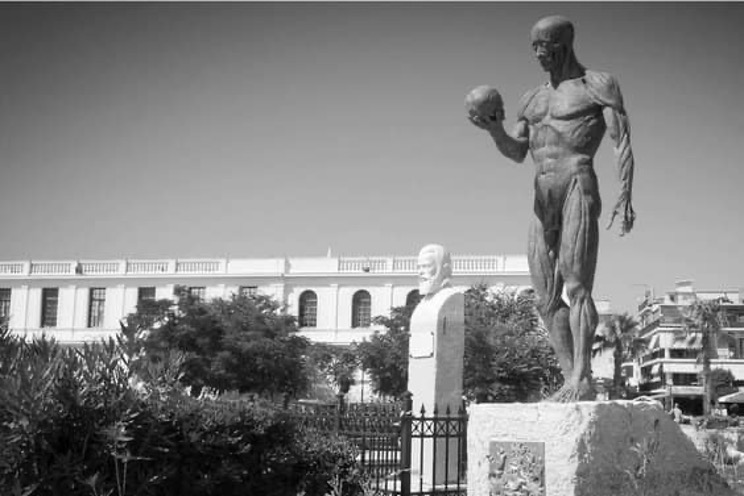
To finance the creation of the monument, we produced a unique sculpture of Vesalius’s head, blending half reconstruction and half portrait, and cast it in bronze. Twelve copies of this distinctive piece were sold, generating the necessary funds for both the production and shipment of the new monument. This monument, a gift to the people of Zakynthos, now stands proudly on Vesalius Square, facing the sea from which Vesalius first arrived on the island nearly 460 years ago.
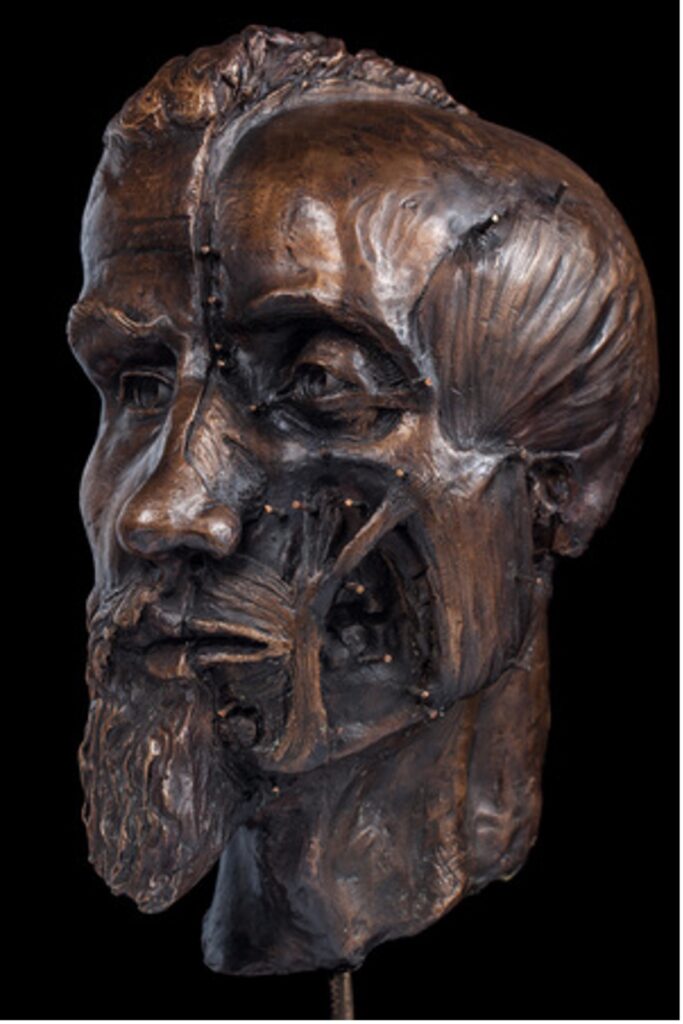
The search for Andreas Vesalius’s lost grave persists as ARSIC founder and medical artist Pascale Pollier-Green http://www.artem-medicalis.com/ and writer and taphophile Theo Dirix http://www.theodirix.com/books.html actively seek funds to start the excavating through various channels. Their efforts include organizing lectures, events, writing books, and articles, all aimed at realizing the ultimate dream of locating Vesalius remains.
